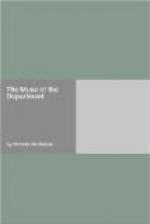Just at this time His Eminence, Monseigneur the Archbishop of Bourges, had converted to the Catholic faith a young person, the daughter of one of the citizen families, who were the first upholders of Calvinism, and who, thanks to their obscurity or to some compromise with Heaven, had escaped from the persecutions under Louis XIV. The Piedefers—a name that was obviously one of the quaint nicknames assumed by the champions of the Reformation—had set up as highly respectable cloth merchants. But in the reign of Louis XVI., Abraham Piedefer fell into difficulties, and at his death in 1786 left his two children in extreme poverty. One of them, Tobie Piedefer, went out to the Indies, leaving the pittance they had inherited to his elder brother. During the Revolution Moise Piedefer bought up the nationalized land, pulled down abbeys and churches with all the zeal of his ancestors, oddly enough, and married a Catholic, the only daughter of a member of the Convention who had perished on the scaffold. This ambitious Piedefer died in 1819, leaving a little girl of remarkable beauty. This child, brought up in the Calvinist faith, was named Dinah, in accordance with the custom in use among the sect, of taking their Christian names from the Bible, so as to have nothing in common with the Saints of the Roman Church.
Mademoiselle Dinah Piedefer was placed by her mother in one of the best schools in Bourges, that kept by the Demoiselles Chamarolles, and was soon as highly distinguished for the qualities of her mind as for her beauty; but she found herself snubbed by girls of birth and fortune, destined by-and-by to play a greater part in the world than a mere plebeian, the daughter of a mother who was dependent on the settlement of Piedefer’s estate. Dinah, having raised herself for the moment above her companions, now aimed at remaining on a level with them for the rest of her life. She determined, therefore, to renounce Calvinism, in the hope that the Cardinal would extend his favor to his proselyte and interest himself in her prospects. You may from this judge of Mademoiselle Dinah’s superiority, since at the age of seventeen she was a convert solely from ambition.
The Archbishop, possessed with the idea that Dinah Piedefer would adorn society, was anxious to see her married. But every family to whom the prelate made advances took fright at a damsel gifted with the looks of a princess, who was reputed to be the cleverest of Mademoiselle Chamarolles’ pupils and who, at the somewhat theatrical ceremonial of prize-giving, always took a leading part. A thousand crowns a year, which was as much as she could hope for from the estate of La Hautoy when divided between the mother and daughter, would be a mere trifle in comparison with the expenses into which a husband would be led by the personal advantages of so brilliant a creature.




